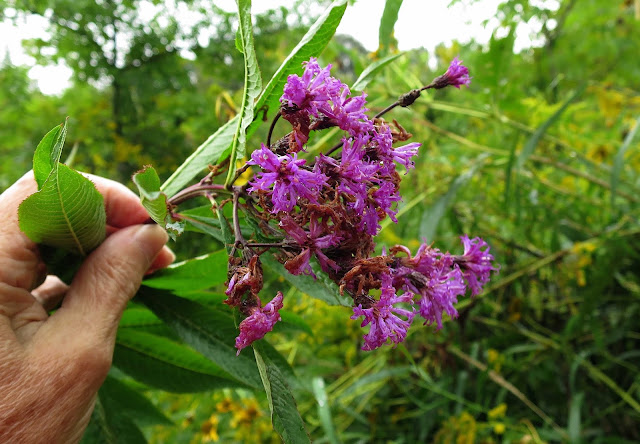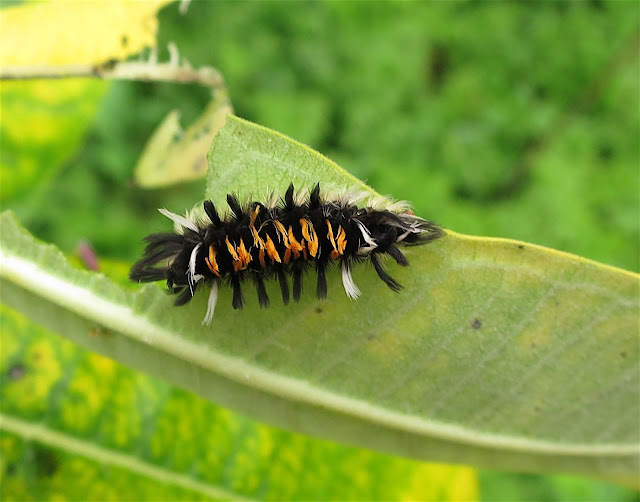My photo journal alerted me that it's time to go looking for New England Asters (Symphyotrichum novae-angliae) and Maximilian Sunflowers (Helianthus maximiliani) along the Kayaderosseras Creek. There's a trail near Ballston Spa called the Burl Trail that closely follows the creek, and that's where I usually go to find these gorgeous late-summer flowers in all their glory. Here's a photo I took of them in early September a couple of years ago, when the New England Asters burgeoned there with both pink and purple flowers, and the Maximilian Sunflowers grew so abundantly I feared they were becoming invasive:
But where the heck are those asters and sunflowers now? This is what the trail along the creek looked like today, with not one New England Aster nor Maximilian Sunflower in sight. Nor many of the other multi-colored wildflowers I expect to see this time of year.
The banks were certainly lush with plants, but far too many of those plants were the very invasive weed called Mugwort (Artemesia vulgaris), which was introduced a few years ago in the root balls of trees that were planted along the creek. I have been aware of this plant's presence since then, but never had I seen it in such massively overwhelming abundance as it has grown this year.
Thankfully, we do have some sturdy native plants that hold their own against a rampant invader like the Mugwort. Certainly the most abundant of those native plants along the Burl Trail are massive numbers of Tall Goldenrod (Solidago altissima). Following a steady rain last night, these tall goldenrods were leaning heavily over the trail today.
A second sturdy native that thrives here is the sunflower look-alike called Oxeye (Heliopsis helianthoides), which also was bent over today from last night's rain.
There ARE several species of native sunflowers that grow along this creek, but it's possible to distinguish the Oxeye by the tiny pistils that can be found where the ray flowers join the disk flowers. No genuine sunflower species has fertile ray flowers like this.
Pale Jewelweed (Impatiens pallida) has such a delicate appearance, it's hard to believe it could hold its own against such alien invaders as Japanese Knotweed and Wild Chervil, which press it on all sides. And yet it thrives here in beautiful abundance.
The same can be said for Pale Jewelweed's orange-flowered cousin, the Spotted Jewelweed (Impatiens capensis), which also grows along these banks. What's doubly remarkable about these two Impatiens species is how well they compete against their invasive neighbors, despite having to grow anew from seed each year. Both species are annuals that reseed prolifically.
Here's another of our sturdier native plants, the Eastern Purple Coneflower (Echinacea purpurea), which today was looking a bit worse for wear. Understandably so, since they have been blooming for several weeks already.
And here at last was one single specimen of New England Aster! This is the deep-rose color variant of this native aster, which usually produces flowers of a vibrant deep purple. I was SO disappointed to not find any others here, but maybe they are just in hiding now, still in bud and not quite ready to show themselves in all their colorful glory.
Here's a photo I took of this trail all abloom with asters a few years ago on a date in late September, so maybe we will yet find this colorful mix along the creek. You can also see abundant numbers of Maximilian Sunflower in this photo, a species that is native to central regions of the U. S. but was introduced at this site back in 2013 when the creek's banks were reconfigured to minimize future flooding downstream. It became so abundant in such a short time, I really did fear that it might become truly invasive, driving out other species that are native to this part of the country.
It truly astounded me today, that I could find no Maximilian Sunflowers, either in bloom or fat bud, since just last year I found them here by the thousands, evident by their towering height even before they opened their flowers. I searched and searched and finally found just a few of its stalks, distinguished by these sickle-shaped down-curving leaves. But that does not look like a flower bud topping the stalk! To me, it looks more like a gall. I wonder if some kind of insect is affecting this plant that is not native to this part of New York, and if this population will disappear because of it. I guess only time will tell!
Well, if one adventive species is about to disappear from this site, it appears that a second one might currently be making a foothold. If a single specimen counts as a foothold, that is. I was quite surprised to find this towering Ironweed plant holding its cluster of purple flowers well about the surrounding flora. I have never seen any Ironweed here along the creek in all the years I've been exploring this trail, neither Tall Ironweed (Vernonia gigantea) nor New York Ironweed (V. noveboracensis).
So which one is this? It's hard to see in this photo, but the bracts that cover the base of the flower head each end in a sharp point, and according to my Newcomb's Wildflower Guide, the bracts of Tall Ironweed (an Endangered species in New York) are blunt or short-pointed, while the bracts of New York Ironweed end in a long thready tip. I believe I will need to get some more experts to weigh in on this before I can be sure.
UPDATE: I did get confirmation from folks at the New York Flora Association that this is indeed Tall Ironweed, an Endangered species in New York. How the heck did it get here? It must have come in when the new plantings occurred, the same way those Maximillian Sunflowers did, which have since disappeared. I sure hope this ironweed lasts a lot longer at this site than those sunflowers did!
All in all, my disappointment in not finding more asters was certainly tempered by my excitement in finding that Ironweed. I was also delighted to find this Monarch caterpillar chowing down on some Common Milkweed leaves. I search and search for these caterpillars every year, and rarely do I find one. But this is the third one I have found this year. I hear reports from others that the Monarch population appears to be rebounding. Hurray!
And I also found yet another milkweed lover, the Milkweed Tiger Moth caterpillar, a very furry critter who (like the Monarch) advertises by its colorful stripes the toxicity it acquires by eating milkweed leaves. I can't imagine any possible predator would enjoy a beakful of all that fur, either.

















3 comments:
Mugwort! I have been wondering what that awful junk was! It showed up here with some hostas we bought and keeping it at bay is a full time job. I hope your asters are just not in bloom yet. I let some go in my garden like garden plants and they aren't open yet either, nor are the ones in the old heifer pasture. Thanks for the info on what that awful weed is!
Amazing how these plant communities change year by year. And this year the growth is so luxuriant!
It's unusual for plant communities to be stable for long periods, too much variation in temperature, rainfall, insect populations and seed production.
Post a Comment